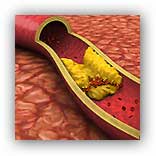News and Insights for
your best life. Online since 1998
- Home Health
- Breaking news
- In caso di...
- Per saperne di
più... - Medicina occidentale
- Medicine complementari
- Medicina cinese
e agopuntura - Omeopatia
- Fitoterapia

The American College of Cardiology and the American Heart Association today released a new clinical practice guideline for the treatment of blood cholesterol in people at high risk for cardiovascular diseases caused by atherosclerosis that can lead to heart attack, stroke or death.
New cholesterol treatment recommendations have come under fierce criticism by top Boston heart researchers for overestimating the number of people who should be prescribed cholesterol-lowering statins, prompting the groups to launch a review of the treatment guide.

The guideline identifies four major groups of patients for whom cholesterol-lowering HMG-CoA reductase inhibitors, or statins, have the greatest chance of preventing stroke and heart attacks. The guideline also emphasizes the importance of adopting a heart-healthy lifestyle to prevent and control high blood cholesterol.
This guideline represents a departure from previous guidelines because it doesn’t focus on specific target levels of low-density lipoprotein cholesterol, commonly known as LDL, or ‘bad cholesterol,’ although the definition of optimal LDL cholesterol has not changed. Instead, it focuses on defining groups for whom LDL lowering is proven to be most beneficial.
The new guideline recommends moderate- or high-intensity statin therapy for these four groups:
Patients who have cardiovascular disease;
Patients with an LDL, or “bad” cholesterol level of 190 mg/dL or higher;
Patients with Type 2 diabetes who are between 40 and 75 years of age; and
Patients with an estimated 10-year risk of cardiovascular disease of 7.5 percent or higher who are between 40 and 75 years of age (the report provides formulas for calculating 10-year risk).
In terms of clinical practice, physicians can use risk assessment tools in some cases to determine which patients would most likely benefit from statin therapy, rather than focusing only on blood cholesterol to determine which patients would benefit.
Two heart researchers from Brigham and Women’s hospital tested a risk assessment tool a few days after it was published in the new guideline and found that it greatly overestimates the risk of developing cardiovascular disease and may result in millions of people being unnecessarily given statins to prevent heart attacks and strokes.
The risk calculator—which takes into account age, race, gender, and heart risks such as high blood pressure and cholesterol—overestimated heart risks by 75 to 150 percent when it was used to predict the 10-year-risk of having a heart attack or stroke in populations that had been followed for decades as part of research studies, according to a new analysis set to be published Tuesday in the medical journal Lancet.
The panel chose to focus on the use of statins after a detailed review of other cholesterol-lowering drugs. “Statins were chosen because their use has resulted in the greatest benefit and the lowest rates of safety issues. No other cholesterol-lowering drug is as effective as statins,” said Dr. Stone. He added that there is a role for other cholesterol-lowering drugs, for example, in patients who suffer side effects from statins.
The report also stresses the importance of lifestyle in managing cholesterol and preventing heart disease. “The cornerstone of all guidelines dealing with cholesterol is a healthy lifestyle,” said Dr. Stone. “That is particularly important in the young, because preventing high cholesterol later in life is the first and best thing someone can do to remain heart-healthy. On the other hand, if someone already has atherosclerosis, lifestyle changes alone are not likely to be enough to prevent heart attack, stroke, and death, and statin therapy will be necessary.”
In addition to identifying patients most likely to benefit from statins, the guideline outlines the recommended intensity of statin therapy for different patient groups. Rather than use a “lowest is best” approach that combines a low dose of a statin drug along with several other cholesterol-lowering drugs, the panel found that it can be preferable to focus instead on a healthy lifestyle along with a higher dose of statins, eliminating the need for additional medications.
“The focus for years has been on getting the LDL low,” said Dr. Stone. “Our guidelines are not against that. We’re simply saying how you get the LDL low is important. Considering all the possible treatments, we recommend a heart-healthy lifestyle and statin therapy for the best chance of reducing your risk of stroke or heart attack in the next 10 years.”
The guidelines are intended to serve as a starting point for clinicians. Some patients who do not fall into the four major categories may also benefit from statin therapy, a decision that will need to be made on a case-by-case basis.
“If experts are having this debate over the new guideline, then what are practitioners and patients sitting on the sidelines going to think?” Dr. Peter Libby, chief of the division of cardiovascular medicine at Brigham and Women’s, said in an interview. “They may hold back on these medications” even though they’ve been shown in recent trials to prevent 20 percent of heart attacks and strokes in those who have certain risk factors such as diabetes, high inflammation levels, and elevated cholesterol.
See also
Study finds link between commonly prescribed statin and memory impairment
US Food and Drug Administration (FDA)
FDA Drug Safety Communication: Important safety label changes to cholesterol-lowering statin drugs
For more information
American Heart Association
ACC/AHA Publish New Guideline for Management of Blood Cholesterol
New cholesterol guideline called inaccurate by top Boston heart researchers
MDN
del Dott. Turetta
Quali sono i problemi o le disfunzioni che possono giovarsi di un intervento omeopatico d'urgenza e, di conseguenza, come dovrebbe essere un ideale armadietto medicinale omeopatico casalingo.- Home -
- Health -
- Depressione -
- Sexuality
- Environment -
- Food -
- Musica -
- Capirsi -
- Grafologia -
- Ridere
Copyright © 1998/2018 www.mybestlife.com tutti i diritti sono riservati eccetto quelli già di altri proprietari.
.In caso di
Pubblicità
Per saperne di più su
Pubblicità
Pubblicità
Pubblicità
Pubblicità


